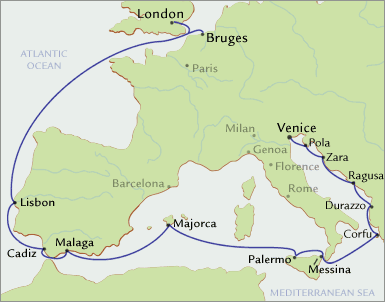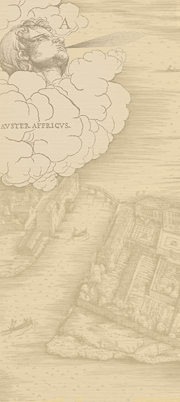Journey Map: Non-Flash Version

Galleys of Flanders
Four or five galleys left Venice for Flanders in late March or early April each year. They were expected back in December after a voyage of seven to eight months. This was Michael's most dangerous voyage since it meant sailing the treacherous waters of the Atlantic for the longest distance without landfall.
Points of Interest
Venice - Located on several islands in a protected lagoon at the head of the Adriatic, Venice was a republic, ruled by its noble families and an elected doge. Halfway between the eastern and western ends of the Mediterranean, it thrived as a trading emporium for goods moving in both directions, as well as over the Alps to Northern Europe.
Michael came to Venice in 1401. He left every year in the war galleys of the Venetian navy or the merchant galleys of the commercial fleet.
London - London, along with Bruges, was one of the two main destinations for the galleys of Flanders. During Michael's time, England was ruled by Henry IV (r. 1399-1413), Henry V (r. 1413-1422), and Henry VI (r. 1422-1461).
Goods traded for here included tin, but English wool was London's most sought-after commodity.
Michael voyaged to London three times with the galleys of Flanders: once as proder in 1406, and twice as homo de conseio in 1438 and 1443.
Bruges - A dominant center of trade in late-medieval Northern Europe, this city in Flanders (now part of Belgium) was the main destination of the galleys of Flanders. The dukes of Burgundy controlled Bruges.
Goods traded for in Bruges included wool and woolen cloths.
Michael sailed to Bruges nine times: as homo da remo in 1404; as nochiero in 1411, 1412 and 1413; as paron in 1420; as homo de conseio in 1417, 1430, and 1441; and as armiraio in 1436.











